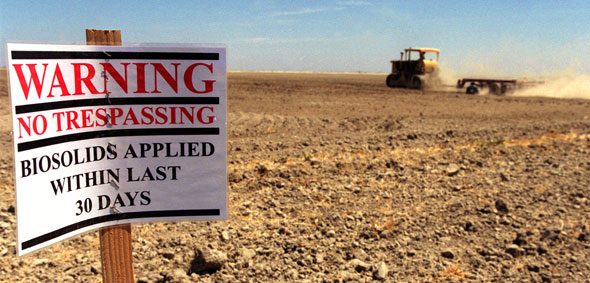08
Jun
Sewage Sludge Fertilizers Sold at Hardware Stores Found to be Contaminated with PFAS Chemicals

(Beyond Pesticides, June 8, 2021) Biosolid-based fertilizer products like Milorganite, often sold to consumers as “organic,” are contaminated with dangerous PFAS chemicals, according to a study published by Sierra Club and Ecology Center. Biosolids, also known as sewage sludge, have been found in the past to contain residues of hazardous pesticides, heavy metals, antibiotics and other pharmaceuticals, personal care products, and a range of other toxicants. While the latest news may not be surprising for careful shoppers who have long avoided biosolid fertilizers, none of these risks are relayed to consumers on fertilizer packages. With fertilizer regulations failing the American consumer, it becomes more important than ever to seek out certified organic fertilizer products.
Sierra Club and Ecology Center looked at nine fertilizer products, each produced from the sewage sludge of a particular American city. For instance, Milorganite, perhaps the most well-known biosolid sludge fertilizer, is derived from the Milwaukee, Wisconsin sewage treatment system. Other products were derived from locations including Sacramento, CA (Synagro); Tacoma, WA (TAGRO); Madison, GA (Pro Care); Las Vegas, NV (Ecoscraps); Eau Claire, WI (Menards Premium Natural Fertilizer); Jacksonville, FL (Greenedge); North Andover, MA (Earthlife); and Washington, DC (Cured Bloom).
As the report notes, many of these products advertise themselves as “organic,” “natural,” or “eco-friendly.” But with these products, “organic” does not mean the same as certified organic products, which prohibit the use of fertilizers containing biosolids. The source of this discrepancy lies with the Association of American Plant Food Control Officials (AAPFCO). Fertilizer labeling is currently enacted on a state-by-state basis, and most states follow AAPFCO’s model language. The group defines organic fertilizer as a material containing carbon and one or more elements other than hydrogen and oxygen essential for plant growth. This definition permits fertilizers to be labeled as “organic” even if they do not comply with the USDA National Organic Program (NOP) standards to produce organic food.
While the U.S. Environmental Protection Agency (EPA) is in charge of regulating sewage sludge, its oversight does not extend beyond pathogens and heavy metals. This leaves a wide range of contaminants that can make their way into lawns and gardens that unsuspecting consumers may think they’ve kept organically managed. As the report finds, PFAS chemicals are a glaring omission by EPA.
PFAS – poly and per fluroalkyl substances – is a moniker representing a wide range of fluorinated synthetic chemicals. These chemicals have been linked to cancer, liver damage, birth and developmental problems, reduced fertility, asthma and a range of increasingly common health conditions. Of utmost concern is that PFAS are considered “forever chemicals,” as there is little indication that these substances break down into a state in the environment in which they do not remain toxicologically active. While there is growing recognition from the Biden Administration that action must be taken on PFAS, the range of new products and places in which the substances are being found highlights the extent of the challenge, and regulators’ collective mistake in allowing these substances to remain on the market in the first place.
Sierra Club and Ecology Center found PFAS in every biosolid fertilizer tested. In fact, each product was contaminated with 14 to 20 different PFAS chemicals, out of 33 that were tested for (and there are over 4,700 different PFAS that have been manufactured, according to the National Institutes of Health (NIH)). Results reveal even higher levels of precursor chemicals to PFAS production, and up to 6,000 times greater amounts of unknown fluorinated chemicals in the tested products. The highest amount of PFAS was found in Cured Bloom Soil Conditioner, produced from Washington, DC’s sewage treatment process. The report notes that a school in the District is using one of the tested biosolid products in its school garden.
While EPA Administrator Michael Regan has begun to look at PFAS in wastewater, and is gathering data from other industries, states are out front in regulating these chemicals. Maine has begun to regulate PFAS contamination in biosolids after discovering PFAS chemicals in its milk supply. Michigan recently crafted regulations around PFAS in biosolids, and Massachusetts, New Hampshire, and Vermont are in the process of establishing oversight.
One source of PFAS in wastewater and the environment likely stems from the application of toxic pesticides. Increasing evidence is revealing widespread contamination of pesticide products with PFAS chemicals, after testing was first conducted by researchers at Public Employees for Environmental Responsibility.
Consumers wishing to avoid the use of dried sewage sludge on their home yard and garden are encouraged to read the fertilizer label carefully. To assist, Beyond Pesticides created a resource of Fertilizers Compatible with Organic Landscape Management. The resource focuses on companies that produce consumer use fertilizers that bear the certified organic label, which never allows the inclusion of biosolid sewage sludge.
Fight back against sewage sludge on your food and in your agricultural community by urging local leaders to prohibit the use of these products on farm fields. Communities across the U.S. have begun to take on this fight. Advocates in Luther, OK, hope that their victory banning the use of biosolid applications in their small town will translate to bigger changes in more farming communities throughout the country.
Additional information on the dangers of biosolids can be found on the report “Biosolids or Biohazards.” And for more information on the developing story around PFAS contamination in pesticide products, attend Beyond Pesticides National Pesticide Forum Workshop on Cutting-edge Science: Environmental Contaminants, featuring Kyla Bennet, PhD, of Public Employees for Environmental Responsibility. Day 3 (June 8, 2021) of the first ever virtual Forum starts today at 1pm: it’s not too late to register to reserve a spot!
All unattributed positions and opinions in this piece are those of Beyond Pesticides.
Source: Sierra Club and Ecology Center Report










